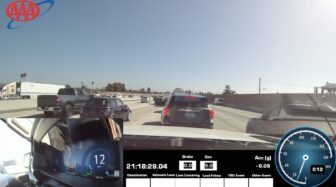Vehicle technology designed to let the car steer and brake by itself is far from foolproof in heavy traffic, and humans must be ready to take action to avoid collisions, according to a new AAA Automotive Engineering study.
Researchers evaluated five passenger vehicles with low-speed-capable Active Driving Assistance (ADA) systems, also known as Traffic Jam Assistance, over an average of 342 miles of driving per vehicle in Los Angeles. ADA can automatically brake and steer in certain situations while requiring the driver to supervise the system.
Researchers found:
- Notable events occurred every 3.2 miles or 9.1 minutes. A “notable” event was defined as any situation in which the ADA system failed to handle the driving conditions adequately, as determined by the researcher driving the vehicle.
- Drivers intervened by taking control of the vehicle every 3.8 miles or 10.8 minutes.
- The most common reasons for intervention were:

-
- An inadequate response to a vehicle cutting in front (every 9.5 miles).
- Inadequate lane centering (every 15.5 miles).
- Failure to resume after a stop (every 24.1 miles).
- Drivers using systems that allow them to take their hands off the wheel still were asked to reengage by putting their hands back on the wheel every 5.5 miles or 15.3 minutes.
“Traffic Jam Assistance promises to offer relief in the most frustrating driving situation: Sitting in stop-and-go traffic. But today’s technology can only supplement, not replace, an attentive driver behind the wheel,” said Alec Slatky, managing director of public and government affairs for AAA Northeast. “Drivers need to stay alert at all times, especially when things get busy on the road.”
AAA offers the following recommendations for drivers to stay safe on the road:
- Remain engaged and prepared to intervene by braking or steering whenever using an ADA system.
- Eliminate distractions, including smartphones — even when using ADA, drivers may need to intervene frequently in high-traffic areas.
- Select a safe following distance to allow time to react and intervene if needed.
- Read the owner’s manual to learn when, where and how to use your car’s ADA system.
AAA aims to collaborate with industry leaders to enhance testing and expand consumer education about vehicle technology. AAA encourages automakers to focus on:
- Enhancing ADA performance, particularly cut-in response and lane-centering behavior.
- Improving the visibility of alerts to ensure drivers are aware when features are active or inactive.
AAA Northeast is a not-for-profit auto club with offices in Rhode Island, Massachusetts, Connecticut, New Jersey, New Hampshire and New York, providing 6.8 million local AAA members with travel, insurance, financial and auto-related services.